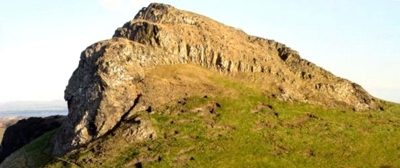42. Binny Craig in Bathgate Hills
Binny Craig is a prominent landmark and a "crag and tail" landform. The crag is part of a sill and is therefore tough igneous rock. The softer sedimentary rocks around it were eroded more quickly, especially by the ice sheet from the west in recent geological time.

The crag is formed of tough igneous rock (part of the Midland Valley Sill) that was surrounded by softer sedimentary rocks which were eroded more quickly, leaving the igneous rock as a prominent hill. This process was accentuated during the Ice Age when an ice-sheet moved west to east through the area. The crag offered protection to the sedimentary rocks in the lee of the ice flow and the erosive power of the ice gradually increased with distance from the crag to produce the tapering "tail".
The crag is made of fine-grained quartz-dolerite, a variety of dolerite that contains small amounts of quartz. It formed when magma intruded into existing rocks, forming a sill (similar to several others in the area: sites 40 and 44). The outcrops of quartz-dolerite display some columnar jointing, and the base of the sill with underlying sedimentary rocks is visible.
On a clear day the summit, with an altitude of 220 metres above sea level, affords an excellent panorama from the Lammermuir Hills and Culter Fell in the south-east around to Ben Lomond and other Highland hills to the north-west.
Binny Craig lies within the Oatridge Campus of the Scottish Rural College at Ecclesmachan, north-west of Broxburn. Public access is by footpath from the minor road near East Broadwood Farm, or, with prior permission, access may be gained via the Oatridge Campus. Nearby geodiversity sites are Greendykes Bing (7), Upper Uphall (11) and Carsie Hill (35).



